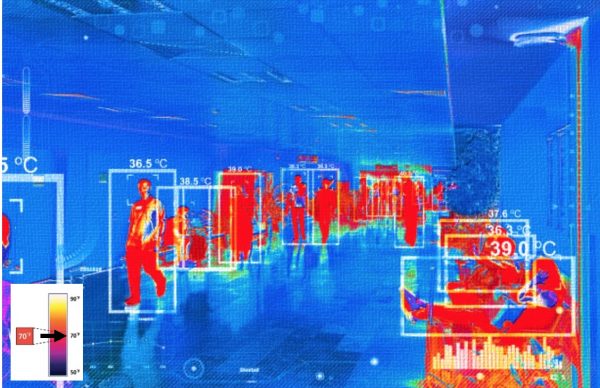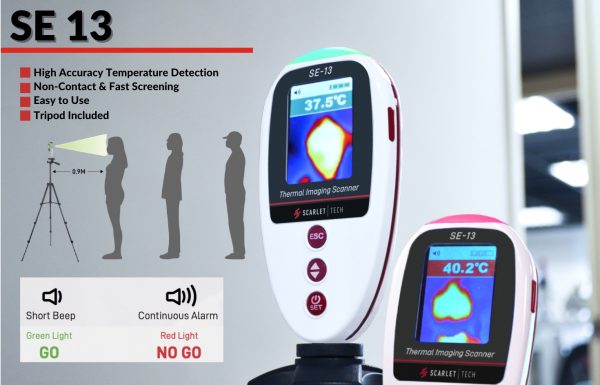Know How –
COVID-19 Prevention: Thermal Scanner Non-Contact Temperature Device
How Infrared Thermal Scanner Help Detects High-Risk Individual?
According to Centers of Disease and Control (CDC), the most common symptom that confirmed COVID-19 patients experience is fever (83-99%), followed by cough (59-82%), and fatigue (44-70%). Among some COVID-19 common symptoms, fever is the most common (83-99%) yet is detectable with the help of technology. Thermal imaging scanner helps to prevent the spread of the disease by detecting individuals with elevated body temperature in a high-traffic places such as airport, office building, supermarket, etc. Experts agree that the technology cannot directly identify COVID-19, but it helps to identify and filter out potential “high-risk” individuals. Thermal imaging scanner serves as a front line screening tool, usually placed at a point of entry, where it detects the body temperature of a group of people at once, contrary to gun thermometer where people need to line up and get checked one by one. In addition, thermal imaging scanner is designed to accurately detect temperature from distance, without close human contact, which reduce the risk of COVID-19 transmission.

How Infrared Thermal Scanner Works
Thermal imaging scanner is easy to use and deploy, simply set it up on the tripod and it will automatically scan body temperature when visitor stand facing the scanner. It uses infrared to detect temperature which can tell us how much heat something has and give us information about the temperature, infrared is a form of electromagnetic radiation that we cannot see but can feel as a heat when the intensity is high enough. Thermal imaging scanner is a combination of a detector and lens that detects temperature and gives a visual representation of the infrared radiation emitted by humans and surrounding objects which is otherwise invisible to naked eyes.
The camera of thermal imaging scanner use a special lens that captures infrared light onto an infrared detector array, which then converts it into electric signal, and processes to create a thermal image (a.k.a thermograph or thermogram) and detect temperature.Different temperature ranges are assigned with a different color which often called as a “false-color” image since the colors are not the original color of the object being imaged. The colors in the image represent variations in the brightness of the object at the observed wavelengths, the higher the temperature, the brighter the color. Thermal image normally does not produce a clear facial recognition image which ensures privacy, as the scanner mainly designed for screening purpose only.

The Future of Infrared Thermal Scanner
Post Covid-19
The use of infrared thermal imaging scanner was popularized during the SARS outbreak in 2003. SARS-affected countries such as China, Hong Kong, Singapore, Canada, and Taiwan have adopted the use of this technology as a frontline screening tool in public places. According to Deep Knowledge Group, a consortium of companies and nonprofits owned by Deep Knowledge Ventures, an investment firm founded in 2014 in Hong Kong, the above-mentioned countries learned well from experience and rank at the top 20 as the safest region during the COVID-19 global outbreak.
As countries easing Covid-19 lockdowns and gradually returning to normal, businesses are looking for ways to keep staff and customers safe.There is a raising awareness in identifying “high-risk” individual with elevated body temperatures, who can be indicative of fever-related illness or might be infected with the coronavirus. Detected individual showing elevated temperatures can either be denied for entry to a place or advised to do further health check for the safety and health of the general. Thermal imaging scanner as a frontline screening tool is the first layer of environmental health and safety control that go alongside with other safety measures such as cleaning.
Thermal imaging scanner is a versatile tool that has been proven useful for strict screening since the SARS outbreak in 2003 and to date 17 years later today, in 2020 with the COVID-19. Since the general public are adopting to the new ways of living of frequent hand washing, social distancing, and wearing face mask, getting a temperature check is also part of the new normal.

SE 13 Non-Contact Thermal Scanner

•Measure temperature & detect fever symptoms in real-time
•Non-Contact. Keep a safe distance between visitors and inspectors
•High accuracy+/-0.3°C
•Capture temperature differences as small as 0.1°C
•Adjustable temperature threshold with optional buzzer alert
•Green/Red Light for instant Go/No-Go indicator
No, thermal imaging cameras cannot be used to detect virus. However, thermal cameras are widely used in public places as a reliable and effective tool for measuring skin surface temperature. People who are identified as having an elevated skin temperature tends to have higher risk of being infected by virus which then can undergo further medical screenings to check health status.
Scarlet SE-13 uses non-contact thermal imaging technology to detect skin temperature.With this technology, thermal scanner not only will show temperature reading but also thermal image of person/object.
Thermal camera detect heat radiation emitted from object/people which then used to measure surface temperature of objects and people. This means with thermal camera has the capability to measure temperature in contactless way.
To get a good temperature reading, it is recommended that the person who wants to get checked be as close to the camera as possible. Scarlet SE-13 works best when the person/object stands at a distance of around 50cm from the thermal scanner.
Scarlet SE-13 thermal cameras capture the temperature differences as small as 0.1°C. When in screening mode, it can achieve accuracy of ±0.3°C at the recommended ambient temperature of 32°C to 42°C.
No, thermal imaging cameras cannot be used to detect virus. However, thermal cameras are widely used in public places as a reliable and effective tool for measuring skin surface temperature. People who are identified as having an elevated skin temperature tends to have higher risk of being infected by virus which then can undergo further medical screenings to check health status.
Scarlet SE-13 uses non-contact thermal imaging technology to detect skin temperature.With this technology, thermal scanner not only will show temperature reading but also thermal image of person/object.
Thermal camera detect heat radiation emitted from object/people which then used to measure surface temperature of objects and people. This means with thermal camera has the capability to measure temperature in contactless way.
To get a good temperature reading, it is recommended that the person who wants to get checked be as close to the camera as possible. Scarlet SE-13 works best when the person/object stands at a distance of around 50cm from the thermal scanner.
Scarlet SE-13 thermal cameras capture the temperature differences as small as 0.1°C. When in screening mode, it can achieve accuracy of ±0.3°C at the recommended ambient temperature of 32°C to 42°C.
Wireless Crane Camera
Why You Need a Wireless Crane Camera System?
Do you know? the major cause of deathly injuries was struck by loads during crane operation, contributing an average of 22% of the total injury, surpassing the number of fatal injury caused by transportation incidents and crane collapses.The most common causes in crane accidents occur in blind lift situations where the operator has limited visibility and therefore is completely dependent to the dogmen, riggers, or signalers to instruct them when moving the loads from one point to another.
Wireless crane camera system is proven to be effective in increasing crane operator job-site awareness by 50%. How wireless crane camera system helps crane operator and businesses?
Heat Stress
What is Heat Stress?
Heat stress is the effect that the thermal environment has on a person’s ability to maintain a normal body temperature. Physical work generates heat in the body which must be lost to the environment through sweating and evaporation. A hot or humid environment makes this more difficult and this can affect both mental and physical performance. Inability to get rid of body heat adequately may result in heat illness.
Workers who are exposed to extreme heat or work in hot environments may be at risk of heat stress. Exposure to extreme heat can result in occupational illnesses and injuries. Heat stress can result in heat stroke, heat exhaustion, heat cramps, or heat rashes.
Other Know Hows
Wireless Crane Camera
Why You Need a Wireless Crane Camera System?
The most common causes in crane accidents occur in blind lift situations where the operator has limited visibility and therefore is completely dependent to the dogmen, riggers, or signalers to instruct them when moving the loads from one point to another. Find out how wireless crane camera system can effectively help in increasing crane operator job-site awareness.
Heat Stress
What is Heat Stress?
Heat stress is the effect that the thermal environment has on a person’s ability to maintain a normal body temperature. Inability to get rid of body heat adequately may result in heat illness.
